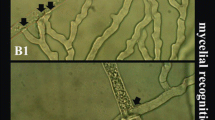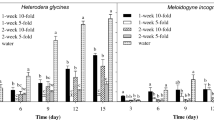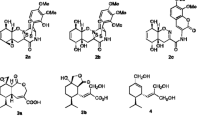Abstract
Pythium myriotylum is a destructive soil-borne phytopathogen, causing yield losses in ginger and many other crops. Environmental and regulatory concerns drive the need to find biological alternatives to conventional pesticides used to manage P. myriotylum. Trans-cinnamic acid (TCA) alone, and fermentation broth from strains of symbiotic bacteria of eight species of entomopathogenic nematodes alone, and in combination with TCA, were tested for their effect on zoospore germination and mycelial growth of P. myriotylum. TCA significantly inhibited mycelial growth. Fermentation broths from seven of the eight strains of symbiotic bacteria directly inhibited mycelial growth, especially those isolated from Steinernema feltiae (strain SN) and S. riobrave (strain 7–12). Moreover, adding TCA significantly increased the inhibitory effect on mycelial growth of the fermentation broths of seven of the strains tested. All bacteria fermentation broths showed inhibitory effects on zoospore germination. However, TCA alone was not inhibitory to zoospore germination but was inhibitory to mycelial growth. Antimicrobial effects on mycelial growth and zoospore germination were proportional to the concentration of symbiotic bacteria isolated from S. feltiae (strain SN). These results show that TCA and symbiotic bacteria of entomopathogenic nematodes may have potential to provide biorational control of P. myriotylum.




Similar content being viewed by others
References
Abdelzaher, H. M. A., Ichitani, T., & Elnaghy, M. A. (1994). Effect of temperature, hydrogen ion concentration and osmotic potential on oospore germination of five Pythium spp. isolated from pond water. Mycoscience, 35(4), 315–318.
Acharya, R., Hwang, H. S., Shim, J. K., Yu, Y. S., & Lee, K. Y. (2019). Control efficacy of fungus gnat, Bradysia impatiens, enhanced by a combination of entomopathogenic nematodes and predatory mites. Biological Control, 138, 104071.
Afzal, M., Alhadidi, D., Menon, M., Pesek, J., & Dhami, M. S. (2001). Ginger: an ethnomedical, chemical and pharmacological review. Drug Metabolism and Drug Interactions, 18(3–4), 159–190.
Ansari, M. A., Tirry, L., & Moens, M. (2003). Entomopathogenic nematodes and their symbiotic bacteria for the biological control of Hoplia philanthus (coleoptera: scarabaeidae). Biological Control, 28(1), 111–117.
Araniti, F., Lupini, A., Mauceri, A., Zumbo, A., Sunseri, F., & Abenavoli, M. R. (2018). The allelochemical trans-cinnamic acid stimulates salicylic acid production and galactose pathway in maize leaves: a potential mechanism of stress tolerance. Plant Physiology and Biochemistry, 128(3), 32–40.
Bhai, R. S., Kishore, V. K., Kumar, A., Anandaraj, M., & Eapen, S. J. (2005). Screening of rhizobacterial isolates against soft rot disease of ginger (Zingiber officinale Rosc.). Journal of Spices and Aromatic Crops, 14(2), 130–136.
Bi, Y., Gao, C., & Yu, Z. (2018). Rhabdopeptides from Xenorhabdus budapestensis SN84 and their nematicidal activities against Meloidogyne incognita. Journal of Agricultural and Food Chemistry, 66(15), 3833–3839.
Boat, M. A. B., Sameza, M. L., Iacomi, B., Tchameni, S. N., & Boyom, F. F. (2020). Screening, identification and evaluation of Trichoderma spp. for biocontrol potential of common bean damping-off pathogens. Biocontrol Science and Technology, 30(3), 228–242.
Bock, C. H., Shapiro-Ilan, D. I., Wedge, D. E., & Cantrell, C. L. (2014). Identification of the antifungal compound, trans-cinnamic acid, produced by Photorhabdus luminescens, a potential biopesticide against pecan scab. Journal of Pest Science, 87(1), 155–162.
Böszörményi, E., Érsek, T., Fodor, A., Fodor, A. M., Földes, L. S., Hevesi, M., et al. (2010). Isolation and activity of Xenorhabdus antimicrobial compounds against the plant pathogens Erwinia amylovora and Phytophthora nicotianae. Journal of Applied Microbiology, 107(3), 746–759.
Caldas, C., Cherqui, A., Pereira, A., & Simões, N. (2002). Purification and characterization of an extracellular protease from Xenorhabdus nematophila involved in insect immunosuppression. Applied and Environmental Microbiology, 68(3), 1297–1304.
Chen, Y. L., Huang, S. T., Sun, F. M., Chiang, Y. L., Chiang, C. J., Tsai, C. M., & Weng, C. J. (2011). Transformation of cinnamic acid from trans- to cis-form raises a notable bactericidal and synergistic activity against multiple-drug resistant Mycobacterium tuberculosis. European Journal of Pharmaceutical Sciences, 43(3), 188–194.
Eroglu, C., Cimen, H., Ulug, D., Karagoz, M., Hazir, S., & Calunak, I. (2019). Acaricidal effect of cell-free supernatants from Xenorhabdus and Photorhabdus bacteria against Tetranychus urticae (Acari: Tetranychidae). Journal of Invertebrate Pathology, 160, 61–66.
Ferreira, T., & Malan, A. P. (2014). Potential of entomopathogenic nematodes for the control of the banded fruit weevil, Phlyctinus callosus (Schönherr) (Coleoptera: Curculionidae). Journal of Helminthology, 88(3), 293–301.
Furgani, G., Böszörményi, E., Fodor, A., Máthé-Fodor, A., Forst, S., Hogan, J. S., Katona, Z., Klein, M. G., Stackebrandt, E., & Szentirmai, A. (2008). Xenorhabdus antibiotics: a comparative analysis and potential utility for controlling mastitis caused by bacteria. Journal of Applied Microbiology, 104(3), 745–758.
Griffin, C. T., Boemare, N. E., & Lewis, E. E. (2005). Biology and behavior. In P. S. Grewal, R. U. Ehlers, & D. I. Shapiro-Ilan (Eds.), Nematodes as biocontrol agents (pp. 47–64). Wallingford: CABI Publishing.
Hazir, S., Shapiro-Ilan, D. I., Bock, C. H., Hazir, C., Leite, L. G., & Hotchkiss, M. W. (2016). Relative potency of culture supernatants of Xenorhabdus and Photorhabdus spp. on growth of some fungal phytopathogens. European Journal of Plant Pathology, 146(2), 369–381.
Hazir, S., Shapiro-Ilan, D. I., Bock, C. H., & Leite, L. G. (2017). Trans-cinnamic acid and Xenorhabdus szentirmaii metabolites synergize the potency of some commercial fungicides. Journal of Invertebrate Pathology, 145, 1–8.
Hu, K., & Webster, J. M. (2000). Antibiotic production in relation to bacterial growth and nematode development in Photorhabdus-Heterorhabditis infected Galleria mellonella larvae. FEMS Microbiology Letters, 189(2), 219–223.
Huang, J. F., Pang, Y. W., Zhang, F. B., Huang, Q. Y., Zhang, M., Tang, S. H., & Fu, H. T. (2019). Suppression of Fusarium wilt of banana by combining acid soil ameliorant with biofertilizer made from Bacillus velezensis H-6. European Journal of Plant Pathology, 154(3), 585–596.
Jeerapong, C., Phupong, W., Bangrak, P., Intana, W., & Tuchinda, P. (2015). Trichoharzianol, a new antifungal from Trichoderma harzianum F031. Journal of Agricultural and Food Chemistry, 63(14), 3704–3708.
Kavitha, P. G., & Thomas, G. (2008). Expression analysis of defense-related genes in Zingiber (Zingiberaceae) species with different levels of compatibility to the soft rot pathogen Pythium aphanidermatum. Plant Cell Reports, 27(11), 1767–1776.
Kaya, H. K., & Stock, S. P. (1997). Techniques in insect nematology. In L. A. Lacey (Ed.), Manual of techniques in insect pathology (pp. 281–324). London: Academic Press.
Le, D. P., Smith, M., Hudler, G. W., & Aitken, E. (2014). Pythium soft rot of ginger: detection and identification of the causal pathogens, and their control. Crop Protection, 65(4), 153–167.
Letsididi, K. S., Lou, Z., Letsididi, R., Mohammed, K., & Maguy, B. L. (2018). Antimicrobial and antibiofilm effects of trans-cinnamic acid nanoemulsion and its potential application on lettuce. LWT, 94, 25–32.
Li, Y., Mao, L. G., Yan, D. D., Liu, X. M., Ma, T. T., Shen, J., Liu, P. F., Li, Z., Wang, Q. X., Ouyang, C. B., Guo, M. X., & Cao, A. C. (2014). First report in China of soft rot of ginger caused by Pythium aphanidermatum. Plant Disease, 98(7), 1011.
Liu, X., Yan, D., Ouyang, C., Yang, D., Wang, Q., Li, Y., Guo, M., & Cao, A. (2017). Oils extracted from Eupatorium adenophorum leaves show potential to control Phythium myriotylum in commercially-grown ginger. PLoS One, 12(5), e0176126.
Lupini, A., Sorgonà, A., Princi, M. P., Sunseri, F., & Abenavoli, M. R. (2016). Morphological and physiological effects of trans-cinnamic acid and its hydroxylated derivatives on maize root types. Plant Growth Regulation, 78(2), 263–273.
Matzen, N., Heick, T. M., & Jorgensen, L. N. (2019). Control of powdery mildew (Blumeria graminis spp.) in cereals by serenade (R) ASO (Bacillus amyloliquefaciens (former subtilis) strain QST 713). Biological Control, 139. https://doi.org/10.1016/j.biocontrol.2019.104067.
Mbarga, J. B., Ten Hoopen, G. M., Kuaté, J., Adiobo, A., Ngonkeu, M. E. L., Ambang, Z., et al. (2012). Trichoderma asperellum: A potential biocontrol agent for Pythium myriotylum, causal agent of cocoyam (Xanthosoma sagittifolium) root rot disease in Cameroon. Crop Protection, 36, 18–22.
Plascencia-Jatomea, M., Viniegra, G., Olayo, R., Castillo-Ortega, M. M., & Shirai, K. (2003). Effect of chitosan and temperature on spore germination of Aspergillus niger. Macromolecular Bioscience, 3(10), 582–586.
Rai, M., Ingle, A. P., Paralikar, P., Anasane, N., Gade, R., & Ingle, P. (2018). Effective management of soft rot of ginger caused by Pythium spp. and Fusarium spp.: emerging role of nanotechnology. Applied Microbiology and Biotechnology, 102(4), 1–13.
Ram, D., Mathur, K., Lodha, B. C., & Webster, J. (2000). Evaluation of resident biocontrol agents as seed treatments against ginger rhizome rot. Indian Phytopathology, 53(4), 450–454.
Richards, G. R., Herbert, E. E., Park, Y., & Goodrichblair, H. (2008). Xenorhabdus nematophila lrhA is necessary for motility, lipase activity, toxin expression, and virulence in Manduca sexta insects. Journal of Bacteriology, 190(14), 4870–4879.
Shanmugam, V., Gupta, S., & Dohroo, N. P. (2013). Selection of a compatible biocontrol strain mixture based on co-cultivation to control rhizome rot of ginger. Crop Protection, 43(1), 119–127.
Shapiro-Ilan, D. I., Bock, C. H., & Hotchkiss, M. W. (2014). Suppression of pecan and peach pathogens on different substrates using Xenorhabdus bovienii and Photorhabdus luminescens. Biological Control, 77, 1–6.
Shapiro-Ilan, D. I., Hiltpold, I., & Lewis, E. E. (2018). Ecology of invertebrate pathogens: Nematodes. In A. E. Hajek & D. I. Shapiro-Ilan (Eds.), Ecology of invertebrate diseases (pp. 415–440). Hoboken: Wiley.
Shi, D., An, R., Zhang, W., Zhang, G., & Yu, Z. (2017). Stilbene derivatives from Photorhabdus temperata SN259 and their antifungal activities against phytopathogenic fungi. Journal of Agricultural and Food Chemistry, 65(1), 60–65.
Shoda, M. (2019). Biocontrol of plant diseases by Bacillus subtilis: basic and practical applications. Boca Raton: CRC Press.
Stilwell, M. D., Cao, M., Goodrich-Blair, H., & Weibel, D. B. (2018). Studying the symbiotic bacterium Xenorhabdus nematophila in individual, living Steinernema carpocapsae nematodes using microfluidic systems. mSphere, 3.
Stirling, G. R., Turaganivalu, U., Stirling, A. M., Lomavatu, M. F., & Smith, M. K. (2009). Rhizome rot of ginger (Zingiber officinale) caused by Pythium myriotylum in Fiji and Australia. Australasian Plant Pathology, 38(5), 453–460.
Tran, H., Kruijt, M., & Raaijmakers, J. M. (2008). Diversity and activity of biosurfactant-producing Pseudomonas in the rhizosphere of black pepper in Vietnam. Journal of Applied Microbiology, 104(3), 839–851.
Vanitha, L. S., Kumari, M., Jayappa, J., & Chandrashekar, S. C. (2010). Symbiotic bacteria, Xenorhabdus spp. of entomopathogenic nematodes: source of antifungal compounds against four plant pathogens. Asian Journal of Bio Science, 5(2), 174–177.
Wakelin, S. A., Walter, M., Jaspers, M., & Stewart, A. (2002). Biological control of Aphanomyces euteiches root-rot of pea with spore-forming bacteria. Australasian Plant Pathology, 31(4), 401–407.
Wang, P. H., Chung, C. Y., Lin, Y. S., & Yeh, Y. (2003). Use of polymerase chain reaction to detect the soft rot pathogen, Pythium myriotylum, in infected ginger rhizomes. Letters in Applied Microbiology, 36(2), 116–120.
White, T. J., Bruns, T., Lee, S., & Taylor, J. (1990). Amplification and direct sequencing of fungal ribosomal RNA genes for phylogenetics. In M. A. Innis, D. H. Gelfand, J. J. Sninsky, & T. J. White (Eds.), PCR protocols: A guide to methods and applications (pp. 315–322). San Diego: Academic Press.
Acknowledgments
This work was jointly supported by the National Key R&D Program of China (2017YFE0130400 and 2018YFD0201002) and the Natural Science Foundation of China (31470495 and 31170412), the China National Tobacco Corporation (110202001034-LS 03), the Yunnan Provincial Company of National Tobacco Corporation (2017YN15 and 2014YN21), the Fundamental Research Funds for the Central Universities to Dr. Ruan and the 111 project (B08011). We gratefully acknowledge Dr. Liu Aixin for providing the information on Pythium myriotylum identification. We also gratefully acknowledge anonymous reviewers for valuable comments on the manuscript.
Author information
Authors and Affiliations
Corresponding author
Ethics declarations
The authors declare that ethical standards have been followed and that no human participants or animals were involved in this research.
Competing interests
The authors declare that they have no competing interests.
Rights and permissions
About this article
Cite this article
Shan, S., Ma, H., Li, Y. et al. Metabolites from symbiotic bacteria of entomopathogenic nematodes have antimicrobial effects against Pythium myriotylum. Eur J Plant Pathol 158, 35–44 (2020). https://doi.org/10.1007/s10658-020-02053-2
Accepted:
Published:
Issue Date:
DOI: https://doi.org/10.1007/s10658-020-02053-2




